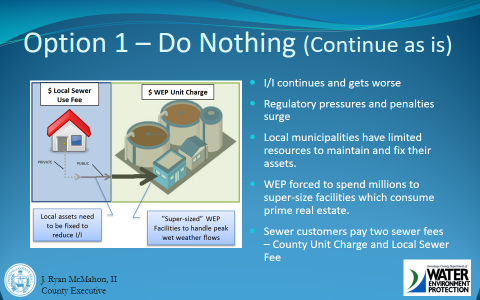COUNTY FACILITIES COMMITTEE MINUTES – JANUARY 14, 2020
DEBRA J. CODY, CHAIR
MEMBERS PRESENT: Mrs. Tassone, Ms. Kuhn
MEMBERS ABSENT: Mr. Bush, Mrs. Ervin
ALSO ATTENDING: Chairman Knapp, Mrs. Abbott-Kenan; See attached list
Chair Cody called the meeting to order at 10:35 a.m. A motion was made by Mrs. Tassone, seconded by Ms. Kuhn to waive the reading and approve the minutes of the previous committee meeting. Passed unanimously; MOTION CARRIED.
1. TRANSPORTATION: Marty Voss, Commissioner
a. Authorizing the County Executive to Enter into a Five Year Agreement with the State of New York for Snow and Ice Control on State Highways for the 2019-2024 Seasons ($3,946,079)
- 5 year agreement with NYS for roads plowed for the state; revenue item; approximate reimbursement
- Baseline level of $1.93 mil based on mileage from state for plowing; this includes a projected amount with severity
- Resolution allows to enter into contracts with state, open account and budget; have to have this; expired last year
A motion was made by Mrs. Tassone, seconded by Ms. Kuhn, to approve this item. Passed unanimously; MOTION CARRIED.
b. 2019 Transfer from Department of Transportation, Account 641010 Regular Employee Salaries, to Department of Transportation, Account 693000 Supplies & Materials $315,000
2019 Transfer from Department of Transportation, Account 691200 Employee Benefits to Department of Transportation, Account 693000 Supplies & Materials $305,000
-
Buy road salt at 60,000 tons/year; last year ran slight deficit on account; taking money from personnel accounts to cover gap and close books on 2019 - $315,000 and $305,000; salt fully stocked, but anticipate more winter weather
-
Really good contract price last year; contract allows for escalation every year; vendor decided to maximize escalation; accepted it, because if it were out to bid, it would be ~$10 - $12 more/ton; better off than state and other municipalities
-
Contract expiring next year; will rebid and cost will go up; Cargill very aggressive with bid; County does combined purchasing with towns and villages, which helps with pricing
-
Looking ahead to see what is going to happen; what other municipalities are getting from other vendors via public bids
A motion was made by Mrs. Tassone, seconded by Ms. Kuhn, to approve this item. Passed unanimously; MOTION CARRIED.
The meeting was adjourned at 10:38 a.m.
Respectfully submitted,

JAMIE McNAMARA, Assistant Clerk
Onondaga County Legislature
.
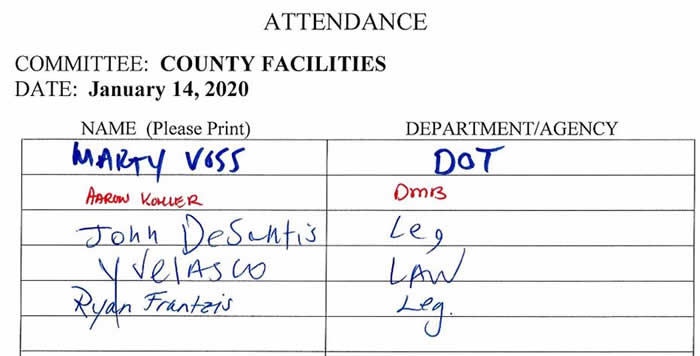
.
.
* * *
.
ENVIRONMENTAL PROTECTION COMMITTEE MINUTES – JANUARY 14, 2020
CASEY E. JORDAN, CHAIR
MEMBERS PRESENT: Mrs. Tassone, Dr. Chase, Mr. Holmquist, Mrs. Abbott-Kenan
ALSO ATTENDING: Chairman Knapp, Ms. Kuhn, Mr. Kinne; see attached list
Chairman Jordan called the meeting to order at 9:03 a.m. A motion was made by Mrs. Tassone, seconded by Mr. Holmquist, to waive the reading of the proceedings from the previous committee. MOTION CARRIED. A motion was made by Dr. Chase, seconded by Mrs. Abbott-Kenan, to approve the minutes of the previous committee meeting. MOTION CARRIED.
1. SOIL AND WATER CONSERVATION DISTRICT BOARD:
a. Confirming Reappointments to the Onondaga County Soil and Water Conservation District Board (Ken Bush, Jr., Julie Abbott-Kenan) (Sponsored by Mr. Knapp)
A motion was made by Mrs. Tassone, seconded by Dr. Chase, to approve this item. Passed unanimously; MOTION CARRIED.
2. OFFICE OF ENVIRONMENT: Travis Glazier, Director
a. Regarding the Onondaga Lake Lounge and Southeast Extension of the Loop the Lake Trail: Amending the 2020 County Budget to Accept Funding from the City of Syracuse for Construction of the Lake Lounge; Authorizing Execution of Agreements; Approving the Classification of an Unlisted Action Under the State Environmental Quality Review Act, Accepting the Environmental Assessment Form and Adopting a Negative Declaration ($500,000)
Mr. Glazier:
-
IMA between the city and county, allows the county to act on behalf of the city in the construction of the Loop the Lake Lounge; county constructing Loop the Lake Trail extension adjacent to the Lake Lounge project
-
Located at the end of the Creek Walk, in severe disrepair, locked up for the past 2 years; the city received NYS grant in 2013 to construct a series of improvements, the project languished under the prior administration and issues with CSX; counties efforts have bird community interested in seeing the area improved
-
City and county discussed projects moving forward at the same construction time; both city and county have a permitting process, Mr. Kerney is present from the city
-
The agreement is modeled after the City Corridor agreement; the city has funding backed up by the state grant, also bonding to take the funding out, will pay the county for work completed and participate with construction oversight as funds are allocated within their budget for construction inspection
-
Design work completed within budget for both the city and county; both projects currently under permit review, subject to DEC approval
-
Need IMA in place to get projects underway; stimulations in the agreement allow either side to terminate the agreement and move forward on their own
-
Provides economies of scale and seamlessness having one contractor instead of 2 trying to meet in the middle
Chairman Jordan asked the estimated total cost of the Loop the Lake Lounge project. Owen Kerney introduced himself and stated that he is with the City Planning Division. The current estimate is about $470,000 which includes alternates that may not be included based on where the bid ends up. It is well under the number Mr. Glazier provided as the ceiling number in this agreement with the county. In answer to Chairman Jordan, Mr. Kerney confirmed that their intent is for the grant to cover 100% of the costs.
Chairman Jordan questioned the no response to several questions on the Environmental Assessment Form (EAF) in reference to the potential for an adverse effect:
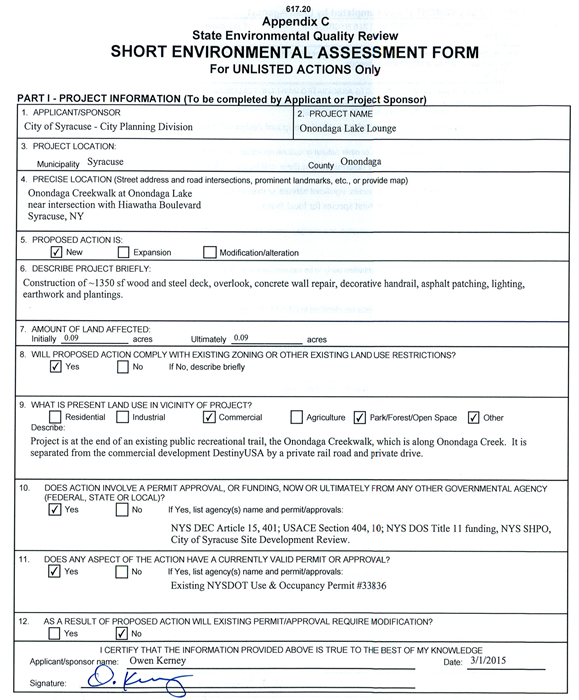
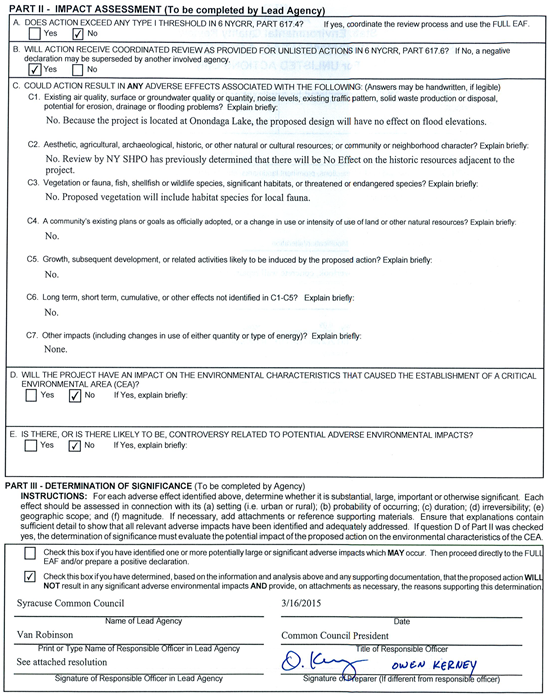
Chairman Jordan said that there are all kinds of contaminates at the bottom of the lake and this is located next to Murphy’s Island. It seems there is a potential risk of disturbing contaminated soil (see C1) and yet their response is that it couldn’t have any adverse effect on the groundwater quality; questions if that is entirely accurate. Also, all are aware of the movement of the bald eagles (see C2), and again the answer was no. The answer to C3 would be yes when building an overlook to attract more people to use the property. Also, the answer to E should be affirmative given the fact that there has already been controversy over what is planned for that area, although it may not be with the city as much. Mr. Glazier responded that this is the city SEQRA for reconstruction; the area is already developed. Chairman Jordan said that when driving new piles they will be disturbing subsoils and water in the area where the crux of most of the contaminants are. Again, it seems that there is the potential for disturbing contaminated soil that could result in some type of adverse impact on water quality.
Mr. Glazier said that he cannot speak to the city SEQRA. The county’s counsel has recommended excepting their SEQRA based on our review. Any project performed there will be overseen by the DEC and is subject to soil management plans and anything that falls under CERCLA. The issues identified are covered under the cleanup. Chairman Jordan said that this resolution asks the legislature to accept the SEQRA and confirm its accuracy.
In answer to Mr. Glazier, Mr. Kerney confirmed that the city council accepted and confirmed the SEQRA a few years ago. This area has previously been built out with seating, lighting, and a paved area. The city is enhancing that area for a variety of reasons but the idea is that the intensity will go back up to what it was when the Creek Walk was originally created. As far as the controversy, there has been broad support for reopening this site from a variety of different users. The point regarding soils is valid; when originally built the city had to perform soil testing and all that documentation has been done. To help address concerns he will see if he can find information that zeroes in on the question of soils.
Dr. Chase asked what happens if the city has its project in place but the DEC doesn’t like the county’s portion for Loop the Lake; will the county finish the project or give the money back to the city. Mr. Glazier responded that he will defer to Mr. Yaus however, this IMA is a reimbursement. The city doesn’t pay the county until the funds have been expended and part of this resolution appropriates funds to provide for that. Mr. Yaus said that if the county project does not advance there are no economies of scale and it wouldn’t make sense to share oversight. It would then fall back to the city as an independent project.
Mr. Yaus said that he has been to some of the hearings and there has always been support for the Lake Lounge. To Chairman Jordan’s point, there are lake remedies that must be complied with. This site is well protected, known, and studied, and they will have to abide by all DEC orders.
Dr. Chase said that the lounge is on existing property and they are now looking to add pilings to give it protection from high water levels. Mr. Owens responded that this is correct, their project is within the existing footprint and they are not encroaching beyond the previously disturbed area. It is enhancing, for lack of a better word, a renovation project to an area that is really popular but showing its age; previously done halfheartedly as an outlook for people to turn around. People have been using the Creek Walk to get out to this area for bird watching, recreation, photos, and everything else you can imagine at the end of the lake, which is the only lakefront that the city has.
Mr. Glazier said that the opening of that part of the Creek Walk was very near the first sightings of bald eagles in that area and he has received countless letters and comments from the birding community asking that the county support the lake lounge. The intent is to be collaborative and make these projects better together; have been talking for about a year and neither wanted to hold up the other. Running parallel paths gives us good reason to bid together and try to get a signal contractor for the whole project. In answer to Mrs. Abbott-Kenan, Mr. Glazier confirmed that the DEC decisions on permits for both projects are within a week or two of each other's schedules.
Mrs. Abbott-Kenan asked what the timeframe would be. Mr. Glazier responded that ideally, they will have someone begin work on April 1; bidding is a process. Some agreements in principals have been made with CSX but they want to talk to the contractor and access is always very complicated with them. The IMA is here to keep this processing going while knowing that if the permit is not issued or not within scope one party of the other can take a step back and the other party can move on.
Dr. Chase said that it sounds like the legal side of the things that could possibly go wrong have been nailed down within the IMA. Mr. Yaus responded that it has been reviewed at the higher levels and there is a final 100% draft available.
Chairman Jordan asked to be provided with a copy of the IMA.
Chairman Jordan said that $25,000 is not much of a buffer and asked who would bare cost overruns. Mr. Yaus responded that the county is reimbursed for all costs of the Lake Lounge.
A motion was made by Mrs. Abbott-Kenan, seconded by Mrs. Tassone, to approve this item. AYES: 4; NOES: 1 (Jordan). MOTION CARRIED.
Mr. Kinne addressed Chairman Jordan stating that he misread the standing committees and is not on this committee, which is why he is leaving.
b. Accepting a Gift of Property from the Finger Lakes Land Trust, Located in the Town of Otisco, Subject to a Conservation Easement, to be Used for Park Purposes
-
Have been working with the DEC and the Finger Lakes Land Trust (FLLT) over the past 2 years for the property on Otisco Lake; the lake is a freshwater drinking source that provides water to OCWA
-
Property privately held in an estate for a long period of time; 35 acres along the shoreline
-
DEC interested in the property due to its impact as a drinking water source, FLLT also interested; after much discussion, the DEC will help with the purchase of the property via a Water Quality Improvement grant as the FLLT intent was to put a conservation easement on the property so that it cannot be developed; this action will improve water quality on a drinking source and a Great Lake within Onondaga County, secondarily this will go into parks property once FLLT has it for a period of time to do plantings for management and maintenance perpetuity
-
Mr. Yaus is working with the DEC and FLLT to smooth out the conservation easement language - intent is to continue in perpetuity to protect water quality; reasonably believe everyone is ok with people walking their dog or fishing
-
Minimal maintenance for Parks; property owners around the lake are excited, unique situation
-
The resolution provides county commitment to take the property and allows the county executive to sign onto the conservation easement
In answer to Chairman Jordan, Mr. Glazier said that this land does not abut the current parkland. Mr. Lansley stated that it is a couple of miles away. Otisco Lake Park is on the northeast side, and this will be on the southeast side.
Mrs. Abbott-Kenan stated that they are totally different. Otisco Lake Park is like a flat load thing where only 6 cars can be parked and it is underwater a lot of the time. This is different and has to be seen; beautiful natural grasslands with butterflies and birds. The beauty of this is that it is natural and the intention was not for 10,000 people to visit the park. The residents want to keep it natural and undeveloped for them to enjoy, and to avoid runoff and sediment going into this drinking source. Maintenance will be minimal mowing of a footpath.
Mr. Glazier said that the property has been mowed for a long period of time and asked Mr. Zepp from the FLLT to speak to the way the environment will change as a result of the work that FLLT will do. Mr. Zepp responded that in conjunction with the development of the conservation easement they are working with the state and the county to develop a restoration plan. This is similar to a 35-acre backyard with scattered shade trees and grassy areas. In some areas, the lake would benefit from planting trees and buffers for runoff and they will be doing some of that prior to county ownership. Then they want to support the county's goals in the development of a long term management plan which will evolve over the next year or two. Their intent is to own it for about a year to get buffers established, per the DEC’s request.

Chairman Jordan referenced the map and asked if the plan was for two restrooms. Mr. Glazier responded no, the orange boxes are observation points. The main responsibilities will be to ensure there isn’t trash and to maintain the mowed path. Mr. Lansley said that Otisco Lake Park is mowed about every 3 weeks in the spring and every month in the summer. It is a couple of acres that is completely mowed. As with Highland Forest, this would be just cleaning up the trail in the spring and summer and doing property checks on a monthly basis in the winter.
Chairman Jordan asked if the box in the upper left-hand corner was a farm. Mr. Glazier responded that it was a residence. Mr. Zepp said that it was a single-family home on ¾ of an acre.
A motion was made by Dr. Chase, seconded by Mrs. Abbott-Kenan, to approve this item. Passed unanimously; MOTION CARRIED.
3. WATER ENVIRONMENT PROTECTION: Frank Mento, P.E., Commissioner; Benjamin Yaus, Senior Deputy County Attorney; Jed Walsh, Project Coordinator
a. Authorizing the Execution of an Order on Consent Relative to the Settlement of an Enforcement Action Brought by the New York State Department of Environmental Conservation
.
Mr. Mento:
- Consent order relative to Meadowbrook-Limestone service area within the consolidated district; important to note the order has been out for a long time
-
Able to negotiate a better deal with DEC due to the consolidation initiative, rather than upgrading or supersizing the plant to accommodate flow violations will perform and catalog I&I work for 3-4 years, submit an annual report on the results of the work and then deal with any plant issues
Mr. Yaus distributed the following revised resolution:
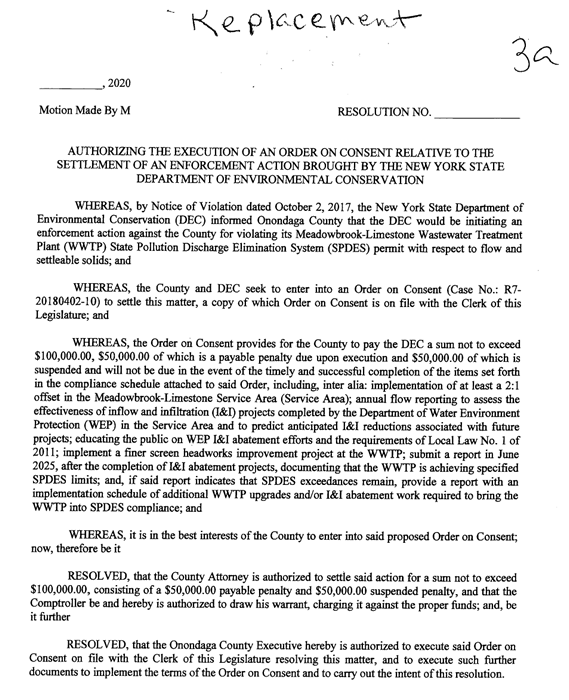
-
Slight revision after talking to the DEC yesterday; terms laid out here were well received and there is a general consensus of how the agreement is going to move forward, hope to have the final agreement complete before Ways and Means
-
Originally there was a $75,000 payable penalty, now $100,000 penalty with $50,000 suspended with compliance, working to reduce that number which is a not exceed amount, also talk of at least a 2 to 1 offset in the Meadowbrook service area; fighting to keep it at 2 to 1, under discussion but well-received recognizing consolidation
-
Onondaga County is the first to do consolidation which is a benefit to the DEC, could be a model for others going forward
-
$9 million investment has gone a long way toward agreement of “implement and see approach” before doing more costly facility upgrades; have everything to gain from investing in I&& work, the more we invest the more we remove and comply with permit limits - if within permit limits after implementation review and reconciliation period facility upgrades will not be needed; have every incentive to make this work, confident great improvements can be made
-
If not within complete SPDES compliance after the final report the DEC will look for major upgrades to the treatment plant
-
Anticipate meeting with DEC next week for final consent order; will revise accordingly if needed
Chairman Jordan asked for clarification on the 2 to 1 offset. Mr. Mento said that for every gallon put into the system by virtue of new development, or something else, they have to remove 2 gallons to comply with the 2 to 1 offset. It is the DEC’s way of saying manage your flows. Mr. Yaus said that it is currently 1 to 1.
Chairman Jordan said that this is a separate violation from the ACJ. Mr. Mento responded that it is totally separate. This is specific to the Meadowbrook-Limestone service area and relates to that plant, not the Metro plant which discharges to Onondaga Lake. As he indicated, this has been a long time coming. The DEC has held off a little bit recognizing where we are headed with consolidation. They have a confidence level that we are making progress with the platform on consolidation and so they have embedded that into this.
Dr. Chase asked if we have the resources to fix the things we are telling them we will fix. Mr. Mento responded yes. For the last year, we have been in the process of identifying the most vulnerable elements in this service area and developed a construction program through our term contractors to attack it. Rights of ownership are needed before we can do this as much of the ownership is town-owned systems.
A motion was made by Mr. Holmquist, seconded by Dr. Chase, to approve this item. Passed unanimously; MOTION CARRIED.
b. Authorizing the Execution of an Order on Consent with the New York State Department of Environmental Conservation Relative to the Settlement of the Amended Consent Judgment
Mr. Mento said that discussion with DEC continues on this item and asked that it be sent to the February committee.
.
No action was taken on this item.
c. A Resolution Calling a Public Hearing in Connection with the Proposed Leasing of Sewer Systems from Certain Municipalities within the Onondaga County Consolidated Sanitary District
.
Mr. Mento:
- The public hearing will ultimately allow the county executive to endorse the leases for consolidation; scheduled for March 3rd
In answer to Mr. Holmquist, Mr. Yaus stated that the hearing will be held in the legislative chamber prior to the session.
Chairman Jordan asked to be provided with the proposed lease agreement.
Dr. Chase asked if they knew who the “certain municipalities” are. Mr. Mento responded that Phase 1 of this is the Meadowbrook-Limestone service area which includes the Towns of Dewitt, Manlius, and Pompey, the Villages of Fayetteville and Manlius, and a portion of the City of Syracuse that resides within those boundaries. Mr. Yaus clarified that it is the entire portion of the city within Meadowbrook.
.
A motion was made by Mrs. Tassone, seconded by Mrs. Abbott-Kenan, to approve this item. Passed unanimously; MOTION CARRIED.
d. Authorizing the County of Onondaga to Act as Lead Agency for Onondaga County Sewage Disposal System Leases Under the State Environmental Quality Review Act; Approving the Classification of a Type I Action; Accepting the Environmental Assessment Form; Accepting and Adopting the Negative Declaration; and Authorizing the Filing, Distribution and Publication of the Negative Declaration
- SEQRA portion of the consolidation effort; county acts as lead agency which means it is controlling the environmental review process
- Letters sent to all involved municipalities across the entire district within the 30-day window; no objections
- Type 1, no significant action on the environment; in essence fixing pipes and manholes
Chairman Jordan stated he has some questions that need to be addressed and will abstain at this time.
A motion was made by Mr. Holmquist, seconded by Dr. Chase, to approve this item. AYES: 4; NOES: 0; ABSTENTIONS: 1 (Jordan). MOTION CARRIED.
e. INFORMATIONAL: Sewer Consolidation Update
.
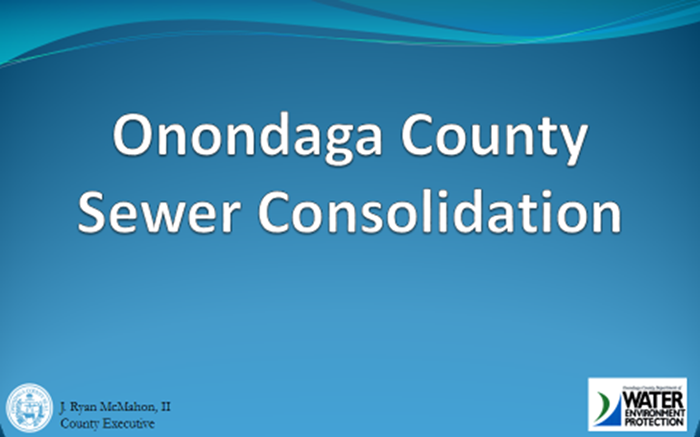
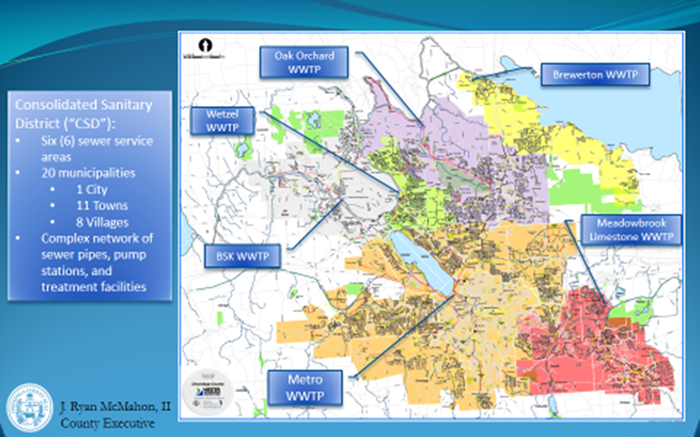

-
Depicts what we are looking to acquire and provides an order of magnitude for the number of assets that would come under our control
-
Blue boxes represent what is currently owned; signification amount of assets are coming our way over time, now under different ownership with varying degrees of age, inventory, and condition which is the precedent for moving forward with this initiative
-
Currently $1 to $2 billion dollars’ worth of assets in WEP’s control, that figure will essentially double
-
This picture reflects a bold but necessary strategy; even though the ownership is segmented the county is on the hook for the end of pipe conditions

-
Annual sewer unit charge is an aggregate of all WEP costs as agreed upon in the budget process; one half of the structure, the other half is equally important, local municipalities have their own systems; because of size and priorities some municipalities don’t always have the opportunity to invest
-
A wide range of fees go along with the local municipalities and are paid by the ratepayers within those municipalities, .i.e. Town of Salina resident may pay a $25 fee to support maintenance or new project development within a town district but is also paying the annual sewer unit charge – trying to remove the double payment by embedding it into one unit charge
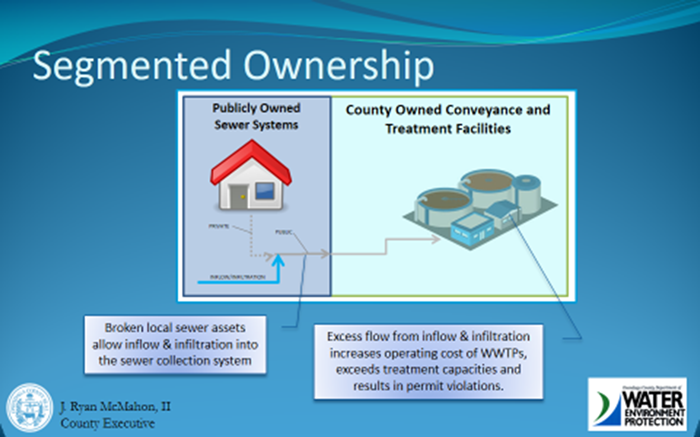

- Action is long overdue; if the system was built today all the sewers would be connected under one ownership
- Do nothing option spends more money to supersize plants; probably not the best solution looking into the future

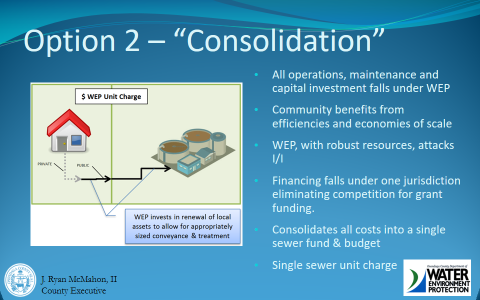
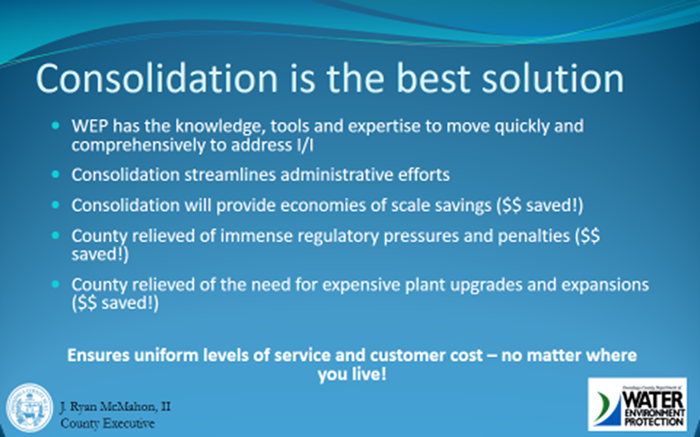

- Intense regulatory pressures because of noncompliance
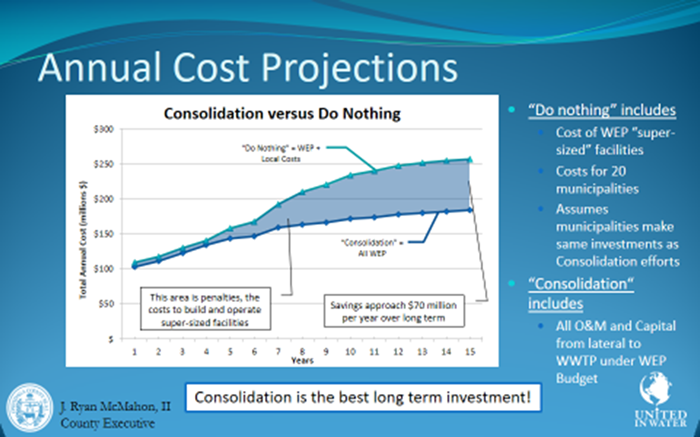
- Significant savings with consolidation – important to see the difference between the options and the impact on WEP’s budget
Chairman Jordan said that it is still a big concern. Costs are going up 80% over the next 15 years even with consolidation. There is an enormous saving but it is still a huge cost increase. Mr. Holmquist said that this is long overdue and it wouldn’t be this bad if it had been done before. Mr. Mento said that nothing can change the past. The county executive and county legislature are coming together to deal with a community issue; didn’t get here yesterday and aren’t going to get out of this tomorrow. These are the steps that will solve a long-standing problem.
.
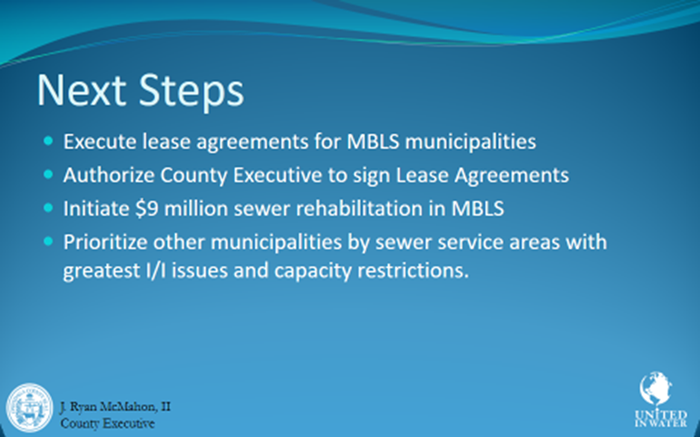
- Work in the Meadowbrook-Limestone service area will immediately commence once lease agreements are signed; $9 million already authorized
- This presentation is a high-level summary of the work completed to get to this point; urge support to move forward
Chairman Jordan asked the benefit to municipalities that have been diligent in maintaining their infrastructure versus those that haven’t. Mr. Mento responded that equity is always an issue here, especially when one service area is benefiting initially and other services areas are coming on in the future. Some kind of balance had to be struck between municipalities with large debt payments on their books and those that don’t. Embedded into the lease agreement, up to $200,000 in “loan relief” will be provided for municipalities with outstanding debt, where the surplus has not erased it. In response to Chairman Jordan, Mr. Mento confirmed that municipalities would pay for any debt beyond $200,000.
Mr. Holmquist complimented Mr. Mento on the synopsis of a complicated problem. A straight forward and easy to understand solution has been put forward and the more people see this the more they will understand the scope of this problem. This is one of the biggest issues we will face in the next decade, if not the biggest in terms of dollars. To Chairman Jordan’s point, there are inequities between districts but that is a function of the patchwork ownership over the decades. This is clearly the right thing to do and he thanks Mr. Mento for his leadership.
Dr. Chase said that historically looking at the money put into fixing pipes and other things $200,000 seems like a drop in the bucket. Mr. Mento responded that district-wide and debt service is not as significant as you would think. Up to $200,000 is to be applied to that debt service and in many cases, it satisfies a heavy portion if not all of the existing debt service, i.e. after the application of $200,000 to the overall debt service of all municipalities in the Meadowbrook-Limestone service area the overall debt service is $100,000 for one municipality. This has been bantered across the board for a long time. Again, this is an attempt to strike a very delicate balance. It is critical.
In answer to Ms. Primo, Dr. Chase confirmed that she was asking about the level of investment anticipated going forward. Ms. Primo responded that they are starting with a $9 million dollar project. The 2020-2025 CIP shows the trajectory of what is anticipated under consolidation, spending $25 to $30 million dollars per year across the entire consolidated district. Big money is going to have to be spent to remediate the local system. $200,000 is for debt relief already on the books of these communities, which will go toward paying that off but the county will be spending a lot more than $200,000 in each municipality that joins. Mr. Mento said that for the most part, the city is not in awful shape in terms of debt service because they are able to generate a significant surplus in their sewer fund.
Chairman Jordan asked for the total debt service for all would-be participating municipalities. Mr. Mento responded that he would get back to him; 3 or 4 municipalities have debt. It is almost a wash for the others with surplus minus debt. Chairman Jordan said that it still seems as if those who are diligent and have more than $200,000 in debt are being penalized, while those who have done nothing walk away with the county assuming a huge liability and everyone paying to upgrade their sewer system. He questions why the county wouldn’t assume all debt service for participating municipalities. Those with more debt service would benefit more than others but rightfully so as they have been more diligent in maintaining their infrastructure. Mr. Mento responded that this initiative is big and they will be taking over a lot of stuff and making investments across the board. To Chairman Jordan’s argument, the $200,000 is one way of saying they want them onboard but it levels the playing field by striking a balance. There are always going to be a couple of outliers, 1 or 2 municipalities with debt, there is nothing they can do about that. It probably doesn’t make the most sense to incur that debt on top of every other investment they will be making going forward. Chairman Jordan said that this is why he asked what the aggregate is - if the difference totals a million dollars it may be worthwhile in recognition of the municipalities due diligence; especially if the difference isn’t significant.
Ms. Primo said that this was a significant issue which they have gone back and forth on and offered these points:
-
Sewers are funded differently; sum out of a sewer fund, others use the general fund so it is hard to know what their debt is and where it should be allocated when it is not in the sewer fund
-
This project will benefit the entire community; if one town or village is left out they could be doing something which is hurting our water bodies or creating extra I & I and we will all pay for it because the sewer unit charge will be increased to address it; attacking this together will be helpful to the entire community whether we spend more in one area than another
-
Towns with a larger amount of debt also have a larger system and taking over their entire system will cost us more money as time goes on; many things aren’t equal but we are trying to make it as fair as possible given that there are so many different factors we have to take care of that are different sizes of different significance across several communities; we are doing the best we can and every point won’t be fair to every community but overall it will fairer and much better than what everyone has right now
-
Every one of these towns will face staggering costs if things don’t change
Chairman Jordan reiterated that he would appreciate having the gross aggregate number of the deficit.
Mrs. Tassone asked if there was any idea how much the unit charge will increase. Mr. Mento responded that it depends on which municipalities and service areas are taken over moving forward. The unit rate charge will go up somewhere in the neighborhood of 5% to 10% depending on which municipalities fall into the next phase and the phases thereafter. Our unit rate charge is not on par with the national average which means we have some capacity. It is time to unite to bring this up a little more and take care of the entire community under one umbrella. There will be bits and pieces of heartache moving through the process but doing nothing will decimate the towns and villages which cannot afford to this work. This is a utility that connects to something we are forced to comply with and if we don’t comply the penalties will come so it is a pay me now or pay me later approach.
Chairman Jordan asked how the projected increase would be 5% to 10% when the total costs are going up probably 80% in 15 years. Mr. Mento responded that is across the entire district and he doesn’t have the exact numbers. They have a five-year projection of what it could be but it is highly dependent upon the number of municipalities. For Meadowbrook-Limestone they are probably looking at a $10 to $20 dollar increase in the next year or two. In response to Ms. Abbott-Kenan, Mr. Mento said that everyone will see the increase. It is the age-old argument about district work, everybody is paying for someone else until everybody is included. Their job is to move this as fast as they can to get everyone included and on the same page.
Mr. Yaus said that there will certainly be kinks to be worked out in the first phase. They designed a lease that is more or less one size fits all but they plan on learning as they go forward, fixing any mistakes and hammering out any unique issues. They are being progressive and don’t have much to base this on.
Ms. Kuhn said that Mr. Holmquist’s point about getting the public on board to understand this was wonderful and asked if there were any plans to make this more public. Mr. Mento responded that this could form part and parcel of the public hearings that are coming. They are also in the Meadowbrook-Limestone areas talking about the same issues with this kind of structure but not with this amount of depth. Mrs. Kuhn said that it was a wonderful presentation. Mr. Mento said thank you.
Mr. Masterpole asked if they looked at forming a sewer authority which shifts the debt and liability of the assets off county government and may make it easier for the towns and villages to buy into. Mr. Mento responded that it was considered a year ago when looking at all the options for moving forward. At that time it was decided to take this approach but down the road who knows what could happen. In answer to Mr. Masterpole, Mr. Mento said that this could evolve into that but he was not going to say for certain one way or the other. For whatever reason, it was decided to do this with a lease arrangement rather than a purchase. Mr. Yaus said that some of this had to do with the timing of the Meadowbrook consent order and setting up an authority is a lengthy process. The leases are written in a manner recognizing that an authority could be set up and are fully assignable to an authority.
e. ACJ Report
.
Mr. Mento:
Mr. Walsh:
- Busy quarter closing out the construction season; some will continue in the spring
-
Had a fair amount of design construction work, significant progress on the CSO 052 project which began Phase 1 in the Strathmore area, continued Phase 2 above Elmwood in the Fairfield – Hutchinson area
-
Held joint presentation for media with the county executive and the mayor showcasing the work in the Washington Square Park area, collaborated with the city to maximize the benefit and provide needed capture
-
Design work on a number of fronts: CSO 010 intersection of Geddes and Fayette Streets, advanced Harbor Brook Sewershed design toward 90%, looking for capture in that district as well as further down the line towards the lake
-
Completed Harbor Brook green streets project across 4 CSOs, expect 3.5 million gallons of capture
-
Wolf Street road reconstruction was a quick in and out procedure, exemplifying city collaboration with a dig once approach and maximizes mobilization costs
-
Partnerships with Onondaga Earth Corps and Cornell Cooperative Extension progressed, over 300 trees planted in the 4th quarter alone, 2 successful Arbor Day events with great outreach and ACJ related capture requirements
-
3 new GIF applications; this program provides the ability to progress in districts where the low-hanging fruit was taken care of early on, need the assistance of the private sector to make further gains
-
DEC accepted the 2018 Annual Report, more importantly, recognized meeting the 95% capture goal which was a major requirement of the 4th stimulation of the ACJ, completed a few years ahead of schedule, currently approaching 98%
-
Long Term Control Plan (LTCP) submitted to the DEC for review, has been a good deal of progress
Chairman Jordan said that essentially we are settling and resolving the ACJ. The LTCP is something we would have to have regardless of this lawsuit. Mr. Mento agreed. Mr. Walsh said that they are streamlining the process and strengthening their relationship with the DEC which is their main regulatory partner.
Chairman Jordan adjourned the meeting at 10:30 a.m.
Respectfully submitted,

KATHERINE M. FRENCH, Deputy Clerk
Onondaga County Legislature
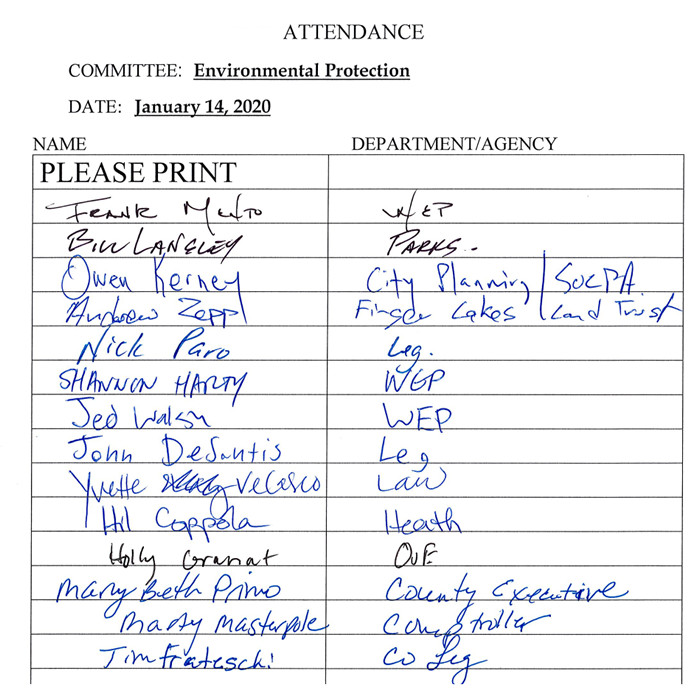
.
.
* * *
WAYS & MEANS COMMITTEE MINUTES
January 27, 2020
TIM BURTIS, CHAIRMAN
MEMBERS PRESENT: Mr. Jordan, Mr. Rowley, Mr. Ryan, Mr. Williams, Mrs. Ervin, Mr. May
ALSO PRESENT: Chairman Knapp, Ms. Kuhn, Mr. Kinne, Dr. Chase, see also attached list
,
Chairman Burtis called the meeting to order at 9:34 a.m.
A motion was made by Mr. Jordan, seconded by Mr. Rowley, to waive the reading of the previous minutes. MOTION CARRIED. A motion was made by Mr. Jordan, seconded by Mr. May, to approve the minutes of proceedings of the previous committee. MOTION CARRIED.
1. COUNTY LEGISLATURE: David Knapp, Chairman; Deborah Maturo, Clerk
a. Changing the Date of the November 2020 Legislative Session (Sponsored by Mr. Knapp)
Chairman Knapp:
- Done every year, as session falls on Election Day
A motion was made by Mr. Jordan, seconded by Mr. Ryan, to approve this item. Passed unanimously; MOTION CARRIED.
b. Standard Work Day and Reporting Resolution
Mrs. Maturo:
- Next round of Standard Work Day reporting, as required by NYS
A motion was made by Mr. Jordan, seconded by Mr. May, to approve this item. Passed unanimously; MOTION CARRIED.
2. CORNELL COOPERATIVE EXTENSION BOARD OF DIRECTORS: Chairman Knapp
a. Confirming Appointments to the Cornell Cooperative Extension Board of Directors (Debra Cody, Mary Kuhn) (Sponsored by Mr. Knapp)
- Legislature has 2 seats on the board of directors
- Legislator Cody requested reappointment; adding Legislator Kuhn
A motion was made by Mr. Jordan, seconded by Mrs. Ervin, to approve this item. Passed unanimously; MOTION CARRIED.
3. ONONDAGA COUNTY TOBACCO ASSET SECURITIZATION CORP: Chairman Knapp
a. Appointing Two Directors to the Onondaga County Tobacco Asset Securitization Corp. (Tim Burtis, Casey Jordan) (Sponsored by Mr. Knapp)
- Very important to our financial standing
- A few years ago we were able refinance debt and bring $3.5 million back into the coffers – thanks to this board and Mr. Morgan
- Membership is traditionally the Chair of Ways & Means, and legislator Jordan has been on it for a long time and offered to stay on
A motion was made by Mr. Rowley, seconded by Mr. May, to approve this item. Passed unanimously; MOTION CARRIED.
4. ONONDAGA COUNTY JURY BOARD: Chairman Knapp
a. Confirming Reappointment to the Onondaga County Jury Board (David Knapp)
- Traditionally the Chair is a member, along with two judges and the Commissioner of Jurors
A motion was made by Mr. Jordan, seconded by Mr. Rowley, to approve this item. Passed unanimously; MOTION CARRIED.
5. TRANSPORTATION: Marty Voss, Commissioner
a. Authorizing the County Executive to Enter into a Five Year Agreement with the State of New York for Snow and Ice Control on State Highways for the 2019-2024 Seasons ($3,946,079)
- Allows State reimbursement for the work the County does plowing State roads for the next 5 years
Mr. Rowley asked how this compares to the last 5-year agreement in terms of the base amount. Mr. Voss said that the base amount is slightly higher. Conditions have to be met for that – metrics with the weather and with the actual snow plow amounts. In answer to Mr. Rowley, Mr. Voss said that there is no change in the severity factor in how it works, but don’t know how it will be calculated until the winter is over. So far this year, haven’t seen much of a significant winter other than ice, which is just as expensive to take care of.
Chairman Knapp asked if a growth factor is included or will the base amount be the same in 5 years. Mr. Voss said that the base amount is unchanged; no growth other than projected increase due to severity. Chairman Knapp asked if we get penalized if there is too little snow. Mr. Voss said that there is a baseline amount of $1,933,301 million regardless of what the winter presents because costs are incurred with materials, labor, and equipment, whether or not there is a severe winter. The rest is dependent upon the weather.
Mr. Rowley said that County doesn’t have any skin in the game as far as negotiating this – it is something we either accept or reject. Mr. Voss agreed – it is uniform across the state.
Mr. May asked for clarification on the answer Mr. Voss gave to Mr. Rowley’s about the formula “we don’t know how it will be calculated.” Mr. May asked if that means that we don’t know what the formula is. Mr. Voss said that it means that we don’t know what the weather will bring. The weather drives what the actual reimbursement will be.
Mr. Jordan asked if ice is part of the equation. Mr. Voss said that it is snow and ice removal – it’s all treated the same. Mr. Jordan asked what the severity factor reflects. Mr. Voss said the trucks going out is our decision to make and manage. The snowfall and weather for the entire state and region is what drives the formula. Chairman Knapp said an inch of snow is one thing, but an inch of ice is another, and it isn’t really accounted for. This is done by region, and our region includes Oswego, which helps us a little bit.
A motion was made by Mr. Jordan, seconded by Mrs. Ervin, to approve this item. Passed unanimously; MOTION CARRIED.
b. 2019 Transfer from Department of Transportation, Account 641010 Regular Employee Salaries, to Department of
Transportation, Account 693000 Supplies & Materials $325,000
2019 Transfer from Department of Transportation, Account 691200 Employee Benefits to Department of Transportation,
Account 693000 Supplies & Materials $315,000
Chairman Burtis asked if the salt price went up. Mr. Voss said that it did not go up; the usage was heavy last year. Come in with budget projections based on price; sometimes we have enough to cover it within our budget; other times we have to move thinks around from other accounts. There were vacant positions that were funded but unfilled and benefits that weren’t spent.
Chairman Knapp said that the County contract on salt is significantly less than the State contract. It was a function of smart negotiation and timing from Mr. Voss’s and Purchasing. All the towns are benefitting; it’s been a huge savings for the County and the towns.
Mr. Rowley asked if there are any other accounts that are available that you use to cover this expenditure, other than employee benefits. Mr. Morgan said that there may be, but are still in the process of finalizing the numbers for 2019. He added that these accounts make the most sense, because we aren’t going to be spending those dollars. Mr. Rowley said that he has a personal preference not to use employee benefits because the 120 account includes hard costs like FICA, as well as interdepartmental costs. Mr. Morgan said that a big portion of the fringe is health and dental. It makes the most sense to him to use the fringe account to balance this out. Mr. Rowley said that it is a hard cost; would rather it come from another hard appropriation account; he does not consider the interdepartmental accounts as hard costs. He looks at it as almost “funny money.” Mr. Morgan said that most of it is, except for this.
Mr. Jordan asked if there are still monies left in these two accounts in DOT. Mr. Morgan said that he is not sure yet – it depends on how we end the year– we are still finalizing the expenditures, accruals--will be finalizing the accounts over the next couple of weeks.
Mr. May asked if the scalable amount was taken for the transfer from the fringe – the FICA associated with the positions, the parts that move. Mr. Morgan said “partially”, then we assume based on estimates that we will be below in other areas.
A motion was made by Mr. Rowley, seconded by Mr. May, to approve this item. Passed unanimously; MOTION CARRIED.
6. ONONDAGA COMMUNITY COLLEGE: Chairman Knapp, Mark Manning, CFO - OCC
a. Resolution Supporting a Permanent Funding Floor for Community College Base State Aid Formula Fiscal Year 2020 (Sponsored by Mr. Knapp)
Chairman Knapp:
- Several community colleges are doing a similar resolution – asking that the funding calculation be more formula based so that the colleges can budget better and more accurately
Mr. Manning:
- This is going across the whole SUNY system; has endorsement from NYSAC
- It is to give predictability and stability to community colleges
- Historically funded on FTE basis based on credit hours – a student takes 15 credit hours in the fall and then 15 credit hours in the spring – they are considered a full-time equivalent
- Under the current rates, the State would give OCC $2,947 for on FTE
- Could also have 5 or 6 par-time students taking just a few credit hours and that becomes one FTE; all of those part time students need the same services as the full-time students; i.e. help with financial aid, advising, counseling, etc.
- This funding formula has been in place since the inception; now have more part-time students
- If they do no change the funding formula, 28 of the 30 community colleges will lose state aid this year – ranging from $50,000 to $4.2 million; 1 will remain flat; 1 will get about an $80,000 increase
- Current year - the State budget put in 98% of prior year State aid – temporary; $2,947/FTE x number of aidable FTEs or 98% of prior year, whichever is higher
- This year most community colleges benefit from the 98% floor; OCC would have lost about $700,000 if the 98% was not put in; next step is making it permanent legislation
- If it goes away, OCC would lose about $2.1 million ($700K this year plus another $1.4 million)
Chairman Knapp said that this is basically making it the way we fund OCC. Mr. Manning agreed.
Mr. Ryan reiterated that OCC would stand to lose $2.1 million on the overall operation budget if the change is made. Mr. Manning agreed, noting that right now OCC gets $19.5 million of State aid, which would go down.
Mr. Jordan said enrollment across the board is significantly down and asked what other methods the college has used to exercise/utilize budget gaps. Mr. Manning said that 82% of their budget is people – salary and benefits. Whenever there is a vacant position, they scrutinize and have conversations to see if there is a need to really fill that position. There are numerous positions that they have not filled. There are a lot of services that the students need and 99% of employees have collective bargaining agreements. There is post-retirement health benefits – even though enrollment may be going down, they still have to fund the retirement costs, which continue to raise. Mr. Jordan asked how many positions have not been filled college wide. Mr. Manning said “at least 15.” He added there is a roster of about 500; additionally, there are part-time adjuncts and have really reduced the amount of them. With the enrollment going down, we are running fewer courses and are trying to maximize course scheduling – making sure the courses are available to the students to get what they need.
In answer to Mr. Jordan, Mr. Manning said that adjuncts are paid per credit hour. There are over 200 full-time.
In answer to Chairman Knapp, Mr. Manning said that right now the part-time students are up a little for the spring; were flat in the fall. Full-time is taking the biggest hit. The economy is actually working against the college; when the economy is really good, people choose to work instead of going to school full time. Chairman Knapp said that the credit is seen on the part-time students under the current formula. Mr. Manning said the biggest impact is on the full-time students. In answer to Mr. Jordan, Mr. Manning confirmed that the part time students add up to full time FTEs; noting that full time was down about 8% this year.
A motion was made by Mrs. Ervin, seconded by Mr. Ryan, to approve this item. Passed unanimously; MOTION CARRIED.
7. FINANCE, DIVISION OF REAL PROPERTY TAX SERVICES: Mary Beth Togni, Assistant Director
a. Approving and Directing the Correction of Certain Errors on Tax Bills
Chairman Burtis noted that some of them are sizeable. Mr. Jordan asked why there was such a difference between the original assessment and the revised. Ms. Togni said that with several of them the schools actually received the money and by clerical error did not record it.
A motion was made by Mr. May, seconded by Mr. Williams, to approve this item. Passed unanimously; MOTION CARRIED.
8. OFFICE OF ENVIRONMENT: Travis Glazier, Director
a. Regarding the Onondaga Lake Lounge and Southeast Extension of the Loop the Lake Trail: Amending the 2020 County Budget to Accept Funding from the City of Syracuse for Construction of the Lake Lounge; Authorizing Execution of Agreements; Approving the Classification of an Unlisted Action Under the State Environmental Quality Review Act, Accepting the Environmental Assessment Form and Adopting a Negative Declaration ($500,000)
-
Allows County to enter into an IMA with City of Syr. for bidding and construction of the City’s Lake Lounge project
-
Fully funded by NYS Dept. of State; money approved in 2014
-
Owen Kerney, City Planning, went after a grant and working with the County because the two projects are adjacent
-
If scheduled aligned it makes sense to work together in how to work with contractors; through permitted process it has become clear that has taken place
-
City/County have experience in working together via IMA – i.e. Connective Corridor Green Infrastructure Project
- Both projects underway this Spring – assuming both get permits
Mr. Rowley said that fundamentally he doesn’t understand why we need an IMA to do this project; the City can bid and conduct the project as easy as we can. He said he understands the need to coordinate, but questioned if it can be done outside of a municipal agreement. Mr. Glazier said that this would put one contractor on for both projects, unlike going out and bidding separately. It provides some benefits on economies of scale – City will be adding linear footboards, steel, pilings, etc., that the County would also be doing in its project. Construction, inspection, and mobilization is also a combined cost – will drive down the cost for both. County gets the benefit of knowing that these two projects will meet each other correctly; the two projects will be completely uniform and seamless. That is the goal from a user perspective – to have a completely connected trail system.
Mr. Jordan asked if the area of lake bed where these pilings are going into contains contaminated soil. Mr. Glazier said that there is an operations, maintenance, and management plan for the lake bottom of Onondaga Lake, and both projects are subject to it. A lot of it has to do with what actually constitutes lake bottom; it’s based on elevation. These particular areas are in ordinary high water; not technically part of the lake bottom. However, both projects are subject to soil management plans, which are overseen by DEC’s Dept. of Environmental Remediation. Mr. Jordan said that his question was “isn’t there contaminated soil that we would be driving the pile into?” Mr. Glazier said that both projects are going to be subject to the same soil management plans, which are controlled by NYS DER. Mr. Jordan asked his question again, stating that it is a very simple question. Mr. Glazier said “I can’t answer that. Environmental Remediation is going to oversee the project; then they will make a determination of whether or not that is material that is subject to remediation.” He said “I can’t tell you what is under there right now because it’s not part of the lake bottom.”
Mr. Rowley noted that agenda items 8 and 9 seem contradictory, noting that no. 8 says that if the project exceeds $470,000, the parties will discuss how the excess cost is apportioned, and if we can’t reach an agreement, then the agreement is null and void. In no. 9 it says that the City will reimburse the County in full. He asked what happens if there are dollars over the $500,000 – who pays it. Mr. Glazier said that the idea is that the County and City can come together and make a determination about the best way to resolve that and can include breaking the agreement and going off their own way.
Mr. Yaus said the he didn’t read them as contradictory; no. 8 is really at the bid phase. That is where we sit down, once the bids come in, to determine if it really makes sense to progress together. It is an initial determination before we start moving into construction hand in hand. The idea is that the grant amount minus the already completed design amount--the City doesn’t really want to exceed on the grant amount they have in funding. He said that when it looks like we are getting close to that number we would analyze it to see if it truly makes sense to proceed this way. The expectation is to come in under that amount and have the grant funds fully reimbursed. The idea is that if we do agree to proceed, and do exceed the amount of grant funding, it does not remove the City’s liability for paying us completely pursuant to this agreement. If costs exceed that amount, the County will still get reimbursed. Mr. Rowley said that we would have to adjust the budget amount in this resolution if it exceeded it. Mr. Morgan agreed, if we want to spend more money.
Mr. Rowley asked if the City is going to borrow for these funds upfront because it’s a reimbursable grant. Mr. Glazier said that they approved a bond authorization. Mr. Kerney said that last week legislation was brought before the Common Council which included a bond authorization. It is not the City’s intention to use that; repayment ultimately is by reimbursement through a grant from New York State – that grant is in order and that is how the City intends to reimburse the County – using those grant funds. In some instance where the funding is delayed or something happens, the backstop being the bonding authorization to secure those funds. Mr. Glazier said that the IMA lays out what the terms are for repayment.
Mr. Jordan noted that the IMA indicates that any change order more than $5,000 has to be approved by the City. If the City doesn’t approve it, then we enter into negotiations. He questioned that if we are half or three-fourths through the project, and then there is a problem that is experienced, and it costs more than $5,000 and the City does not approve that additional expenditure, then where are we? Mr. Glazier said that as with most IMAs you think there is a cooperative effort. The City is aware of what the constraints are within this project area and feels good about where their design is, as does the County. We are all subject to in the field changes; this $5,000 increment was intended so that if we have lower amounts, that projects aren’t delayed over a $200 change or within the contingency. If there is something above the $5,000, then this agreement sets out that the two parties should come together within reason to figure out how to move forward. Mr. Glazier continued saying the total objective is to be cooperative. The City’s intention is to complete the project; both parties are interested in seeing the project completed and recognize that there are a lot of unknowns out there; it’s our goal to work together to try and resolve those.
Mr. Jordan said that he is hearing that there is a possibility that a situation could come up where the City will not agree to a certain change, which could put the County in a position of now having to make up that difference. So it’s not necessarily going to be completely on the shoulders of the City. Mr. Glazier said that he doesn’t think that it necessarily says that. Mr. Jordan said that it absolutely does – it says that it has to be a mutual agreement; if we don’t reach an agreement – it doesn’t say that the City will be obligated to pay the difference. The question becomes, “If we can’t come to an agreement, then where are we?” The agreement doesn’t say that the City will absolutely be responsible for the cost; it says “we will talk about it.”
Chairman Burtis said that it says “if after a good faith effort no agreement is reached, this agreement shall be null and void and the City shall reimburse the County only for monies expended to date under this agreement.” Mr. Jordan said it is null and void, so then we have no contract. If we are 80% into the contract, and now the contract is null and void…do we have an observation deck that is 80% complete? Mr. Jordan said that we know it’s not going to happen. Mr. Yaus said that there is change order in every project; we are trying to come together to realize efficiencies here. If the City did not approve, and it’s over $5,000, outside the project contingency, then it is not an approved change order. The County wouldn’t be paying for it because it wouldn’t be an approved change order subject to the contract. He said that we would have to figure out another way to accomplish the goal. Any change order is subject to mutual agreement; we are not on the hook for paying for it. Mr. Jordan said that it doesn’t obligate us to do that. From a practical standpoint, if it’s 80% complete and the City won’t agree to it, then his gut feeling is that ultimately the expectation is going to be that the County come up with the money to finish the project. Mr. Yaus said that the agreement is that the City will be paying all costs; it’s their project, we are not trying to take it away – just trying to realize efficiencies.
Mr. Glazier asked Mr. Kerney, as a City representative, if it is the City’s intent to complete the project. Mr. Kerney said that the City is under contract with NYS and has to deliver a project. That is the City’s motivation, as well as to provide an amenity to the public. Ultimately, the City has a grant with NYS, and it is clearly identified that we have to complete the project this year--we are obligated in that sense. Mr. Jordan asked if the grant funding would not come in if the project were not completed. Mr. Kerney said that if the project was not completed, it could jeopardize the grant funds.
Mr. May said that he does not have a problem with the project – the end result will be a plus for the lakefront. Legislator Jordan brings up some valid points, but it also sounds like the contract accounts for a lot of the concerns that are there, and the City’s full intent is to get the project done and funded. He said that he does not like that so much is being done in this resolution – amending the budget to accept funds, authorizing the IMA, and the whole SEQRA process, all in one shot. If there were issues, and we get stuck on an issue, then the whole thing doesn’t proceed. He cautioned, as it is a big bite doing it this way and does not recall ever seeing money in a SEQRA resolution.
A motion was made by Mr. Williams, seconded by Mrs. Ervin, to approve this item. AYES: 5 (Burtis, May, Williams, Erin, Ryan); NOES: 0; ABSTENTIONS: 2 (Jordan, Rowley). MOTION CARRIED.
b. Accepting a Gift of Property from the Finger Lakes Land Trust, Located in the Town of Otisco, Subject to a Conservation Easement, to be Used for Park Purposes
-
Property on south end of Otisco Lake – owned by the Henderson family for approx. 80 years
-
Their estate was looking to sell property; Finger Lakes Land Trust and DEC were looking at the property
-
It’s undeveloped, mowed, 35 acres on the shoreline of Otisco Lake
-
FLLT and DEC saw this as an opportunity to improve the water quality of Otisco Lake, a drinking water source
-
Through Water Quality Improvement funding through DEC, the property is in the process of being purchased from the Henderson estate
-
County agreed to accept the property after some improvements to the site, primarily ecological
-
In next 12–18 mos. will take ownership after a conservation easement is in place--will be County park property
-
Brian Kelly is present from Parks – has worked in that area with the other Otisco property; County Parks does not see it as a major obligation as far as maintenance – not a lot mowed areas or paved areas – the idea is just to get more capture of that water as it runs down the hills
In answer to Mr. Jordan, Mr. Glazier said it the trail will be mowed, no stone put down – for dog walking, biking – a connective type path; there are some points where someone could fish, but it is shallow. Mr. Jordan asked about observation points. Mr. Glazier said that it is really a bluff – there are some trees down, which they are going to clean up. The crux of the money is going to plantings. He referred to the map below – a lot of the plantings are going in the orange and light blue areas; the red is a low-contact, forever wild area – it’s very thick in there.
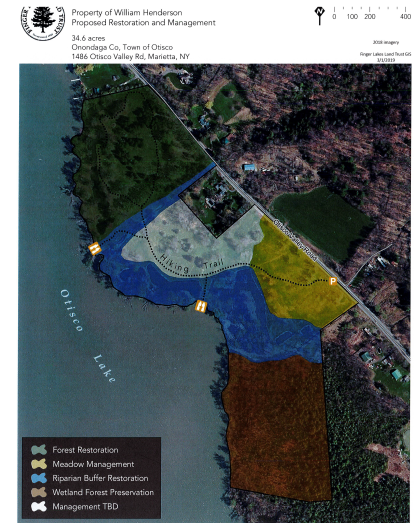
Mr. Rowley asked about parking. Mr. Glazier said that in working with the Parks Department, a determination was made the smaller is better. It is a small area – just large enough for people to turn around. If you get a big large parking area out there -- it is really remote, and sometimes things get dumped out there.
Mrs. Ervin asked if there is any reason why we should not accept this; Mr. Glazier said “no”.
A motion was made by Mrs. Ervin, seconded by Mr. Ryan, to approve this item.
Mr. Jordan asked if there is an expectation of how many people will be using the trail. Mr. Kelly said that he thinks here would be a decent amount of attendance at it. With the other property on Otisco that is currently being mowed, a lot of folks are looking for the experience of hanging out by the water, have a sandwich, maybe throw a line in the water. He said that we could see quite a few people out there looking for that experience. Mr. Jordan said that he would be concerned about the small parking lot if there are going to be a lot of people going there; people may park along the road and that may not be the best situation. Mr. Glazier said that the conservation easement does allow for expansion of the parking area; it is the one thing that Finger Lakes Land Trust put in there. Out of the gate, the idea is to keep it small. Mr. Kelly said that there is parking for 10 cars at the other Otisco Lake property. Mr. Glazier said this will be a smaller parking space. He noted that the other property is big, and open, maintained and mowed; this will be really overgrown and just a trail.
A vote was taken on the motion to approve. Passed unanimously; MOTION CARRIED.
9. WATER ENVIRONMENT PROTECTION: Frank Mento, Commissioner
a. Authorizing the Execution of an Order on Consent Relative to the Settlement of an Enforcement Action Brought by the New York State Department of Environmental Conservation
- Order of consent for the Meadowbrook Limestone treatment plant and the conveyance area that serves it
- Been on the books for quite a while; finally reached consensus through series of negotiations with DEC
- Have some good and favorable terms
- Consolidation done over the last year has helped tremendously – DEC recognizes and endorses that effort
- Able to starve off major expenditures that could have been at the forefront – treatment plant negotiations
-
First 3 – 4 years will be doing a lot of infiltration/inflow abatement work – already authorized, $9 million
-
Will move forward after 3 -4 years, if need to, with treatment plant improvements
Mr. Yaus said that this has been on EPA’s and DEC’s list as one of the longest. It is a complicated site, a complicated issue; there are a lot of things in the background like consolidation. We were waiting for the consolidation piece to advance and were able to get credit for this legislature’s investment of $9 million. This is a big step and are incentivized to get it done before the 2025 period, when greater plant upgrades might have to be considered.
Mr. Jordan asked what happens if we are unable to meet the schedule of work that has to be done. The agreement calls for $100,000, $50,000 deferred, and on top of that if there is a breach to the order, it is $100 per day additional penalty. Mr. Yaus said that he was attuned to that issue too; raised the point numerous times that it is kind of ridiculous to have a suspended penalty and then a stipulated penalty structure. However, we were able to get some concessions – they dropped the stipulated penalty by $150. In past history, the ACJ 30 years stipulated penalties were few and far between and really none in the latter half of the ACJ. DEC has always been willing to work with us; WEP does a good job of hitting the ground running. He noted that Mr. Jordan’s point is well taken. We don’t expect any; a lot of these are reporting; a lot of the factors and negotiations were with timing so that we didn’t run into this issue. Mr. Jordan noted that one of the problems we were having with the ACJ was that the goal posts kept getting moved throughout the process. He asked if there is a concern that the goal post may get moved by DEC throughout the course of this agreement. Mr. Mento said that there are hard stops at certain points along the way, so it is conceivable that we will get to a point--will have to assess it and then decide what needs to be done. Mr. Mento said that he does not see the finish line moving; he sees negotiating based upon data that we have, which is why they allowed us to take this route.
Mr. Ryan said that he has concerns about “if we don’t get this done, how much are we going to have to pay.” It’s a hypothetical; obviously, it is the understanding that if we are spending this money to do this, we are taking corrective actions, WEP is doing everything that they can do. He asked if it is fair to say that there are penalties that DEC might say “that’s negotiable; I understand you are putting up the best faith – we aren’t going to start fining you every day because you guys are doing what you said you would do.” Mr. Yaus agreed that is fair to say. He added that whenever we get close, we are good about sending out a 30-day letter that we are getting close to the deadline and need a little bit more time. Then another period of time, another deadline, is negotiated.
Mr. Rowley asked if sewer consolidation has to take place before this work can be done. Mr. Mento said that they go hand in glove; the good news is that the $9 million has been allocated – the source of funding is there. He thinks that we have to move in parallel with sewer consolidation efforts so that we can get access. Mr. Rowley said “the question is -- you need the lease agreement?” Mr. Mento said that we need to run them in parallel.
Mr. Rowley asked Chairman Knapp if this legislature is going to be able to vote on the actual lease agreement. Chairman Knapp and Mr. Durr confirmed that the legislature will be voting on the lease agreement. Mr. Rowley said that this exercise, if the lease agreement doesn’t go through for whatever reason, is null and void. Mr. Mento said that he didn’t know and would defer to Mr. Yaus, adding that it is a consent order and obligates us to take whatever actions are necessary. He said that he is not so sure how it factors in legally as to what they own, what we own, and where we can work. Mr. Rowley said that he would like to know. Mr. Yaus said that the idea was that we have all had and understanding with the DEC negotiations that we would like to get back tighter and convene if consolidation doesn’t happen. He said that this does commit us; there is not contingent language in here regarding consolidation happening. The issue would just be accessing satellite systems that municipalities own to do the $9 million worth of work. Previously, there was an IMA structure, which could be used to grant access to do these improvements, which still benefit our plans – I&I work that was already planning for when the $9 million was originally appropriated. The understanding was that we might have to go back and consider this, but it the leases fall behind, we would reconvene and see what the best way is to do it. He said that there are other ways to do the work if need be.
Mr. Mento said that the consolidation issue is very significantly factored into the timeframe, by which we were able negotiate, extend, and account for a potential time lapse, in coordinating the two efforts.
A motion was made by Mr. Ryan, seconded by Mrs. Ervin, to approve this item. Passed unanimously; MOTION CARRIED.
10. STEAM SCHOOL: Ann Rooney, Deputy County Executive/Human Services
a. INFORMATIONAL UPDATE
Ms. Rooney:
Mr. May asked about the lease moving here and asked what that means in terms of time and with the bonding. Ms. Rooney said that they hope between now and the State budget passage is to have it all to the legislature, contingent on State budget approval -- have the lease with the School District and the IMA with the City approved. Components in the IMA, because of the relationship between the School District and City, we need to have both the lease and IMA in place. Once those pieces are in place, we can go right to bonding and get the procurement going. Mr. May said that we don’t have to anticipate a mad rush for these two items – they can just move through as needed because we have until April to vote on it. Ms. Rooney agreed.
Mr. Rowley asked if the governor’s proposal to fund this is through normal school building aid; is there an assumed debt service and it gets paid over 20 years or whatever it is. Ms. Rooney and Mr. Morgan confirmed that it is.
Mr. Jordan asked when it is anticipated that the legislature will have a draft IMA and lease agreement. Mr. Durr said that they have been going back and forth for 6 weeks; just sent a proposal over from the County last Friday. Hopefully will have a final draft of the lease in the next week or two. The IMA should be less of a problem because conditions of the IMA will be in the lease also. Once that lease is in place everything else should fall in place pretty quickly.
Mr. May said that there will be a process for all of these pieces, which will be pretty demanding. He asked which program committee will get its arms around this. Chairman Knapp said that it is a unique situation; we are simply bonding for the project, but the project isn’t ours necessarily. He said that our role mainly is to approve the bond and to make sure that the IMA and the lease are such that the County’s interests are protected and that it is something that we want to do. The original thought was to just keep it at Ways & Means Committee – it doesn’t fit into other committees.
Mr. Ryan asked who the parties of the lease are. Ms. Rooney said that it will be the County and the Syr. School District. Mr. Durr pointed out that the School District is part of the City.
Mr. May asked who will be managing the construction if the bonding is approved. Mr. Durr said that the County will be managing the construction. Mr. Wixson said that the County will act as a landlord and are doing the preparation and construction. He said that we will have a facility that we will lease to the City School District.
11. FINANCE: Steven Morgan, CFO
a. Monthly Report - Double Encumbered Positions (Res. 86-2018)
- Next month a handful will come off the report including Comptroller and Finance positions
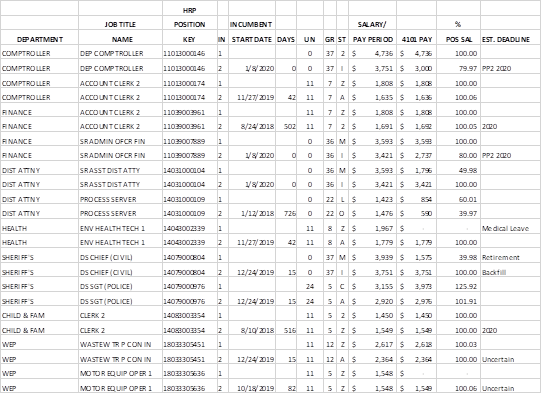
A motion was made by Mrs. Ervin, seconded by Mr. Ryan, to adjourn. Passed unanimously; MOTION CARRIED.
The meeting was adjourned at 10:40 p.m.
Respectfully submitted,

DEBORAH L. MATURO, Clerk
Onondaga County Legislature

. . |














